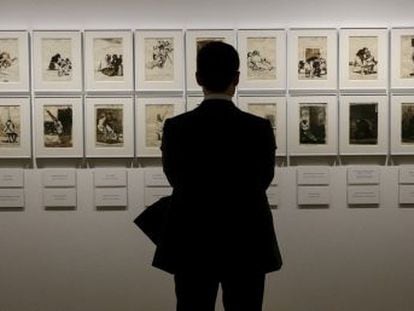Madrid’s Prado museum seeks a solution for its most popular artworks
Constant overcrowding in rooms housing paintings by Hieronymus Bosch leads to a new display design

If you want to see the demon holding the mirror held up to the lady who is getting dressed, you have to get very close to Hieronymus Bosch’s The Table of the Seven Deadly Sins, which he painted between 1505 and 1510.
The lady has forgotten God and is rejoicing in her own image, egged on by the demon who is luxuriating in her self-absorption. To appreciate the Dutch painter who made it his mission to show the way in which passions can blind humanity, you need time and space. But this has become all but impossible given the number of visitors who crowd into the Prado museum to see his work.
To address the problem, the Madrid gallery has just come up with a new way to display the works of one of its most popular artists. The museum is in fact going back to a style of installation similar to the one it used prior to 2016, when large curved stands were introduced for a temporary exhibition and subsequently kept on.
With the Prado’s bicentennial celebrations, it became increasingly clear that these supports were impeding the flow of visitor traffic and causing a bottleneck in front of The Garden of Earthly Delights, which is once again to be hung on the wall.
“The idea was to create a space between the artwork and the public, but we realize that it has been problematic. They are so voluminous that they get in the way,” says Karina Marotta, the Prado’s conservation coordinator, about the 2016 supports.
The new supports are lighter, according to Marotta. “But they are on trial run,” she adds. “We have to keep trying new things, because there is no ideal solution when it comes to these overcrowded rooms.”
The congestion is, to some extent, specific to Bosch. The same concentration of visitors rarely gathers in front of Velázquez’s Las Meninas, for example, because the space there is larger and the audio guides last just half of the time (four-and-a-half minutes) spent explaining Bosch.
With audiovisual aids, visitors can enjoy Bosch in a different waySara Bono Perucho, expert in cultural heritage management
The most striking change will be the installation of screens showing details of the paintings. “Perhaps they will prove a helpful resource for enjoying a complicated room and complicated works, which people tend to stare at for long periods,” says Marotta. “Bosch is attractive even to teenagers.”
The screens should act as an additional resource, mitigating the time needed to contemplate the works directly, while not replacing it altogether. The overhaul coincides with a 16.2% hike in the number of visitors this January from 2019, linked to the bicentennial celebrations. This is the first time that the Prado has seen as many as 249,650 visitors at this time of year, and while this might seem like a cause for additional celebration, it has flagged up the overcrowding issue.
The museum is aware that it is all but impossible to appreciate the details of complex works of art such as those made by Bosch, with their myriad of tiny scenes, when the visitor is being jostled by others intent on doing the same thing.
Sustainable visit
“We are going back to a more social model of aesthetic appreciation, typical of the 18th century,” say Jaime Cuenca and Fernando Bayón, leisure researchers at Deusto University. “There’s less individual contemplation and more interaction, whether sharing the experience, perhaps via social networks as opposed to in person, or getting information from experts via apps as opposed to exhibition catalogues. None of these changes in the visitor’s experience are necessarily a bad thing.”

According to Antoni Laporte, from the cultural consultancy ARTImetría, mass consumption of art is a phenomenon peculiar to large museums. This expert in cultural policy and management points out that overcrowding needs to be controlled; that even though museums have to keep increasing their visitor numbers, they also have to focus on getting visitors to give increasingly positive ratings to their experience year after year.
To avoid overcrowding, Laporte proposes adjacent spaces, with audiovisual images showing details of the artwork in question. He agrees with Sara Bono Perucho, an expert in cultural heritage management, who says: “With audiovisual aids, visitors can enjoy Bosch in a different way. It is the perfect distraction for visitors, preventing them from staying too long in front of an exhibited work and allowing them to experience art more interactively.”
Experts believe that when it comes to exhibiting masterpieces, the number of visitors allowed into a room at any one time should be monitored, a measure that the Prado has not yet established for the Bosch gallery.
Meanwhile, Cuenca and Bayón are proposing new interpretations of the collections to create an alternative narrative. “Perhaps this would stop the ‘masterpieces’ from being the only focal point of the collections, and we would solve several problems at once,” they say.
These two experts would like to see the most prestigious museums take a closer look at how their collections are designed, with a view to putting an end to the “fetish” status of particular works that stops visitors from getting the most out of the installation as a whole.
English version by Heather Galloway.












































